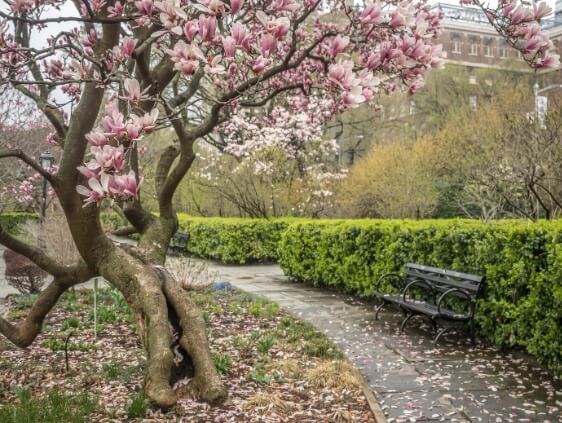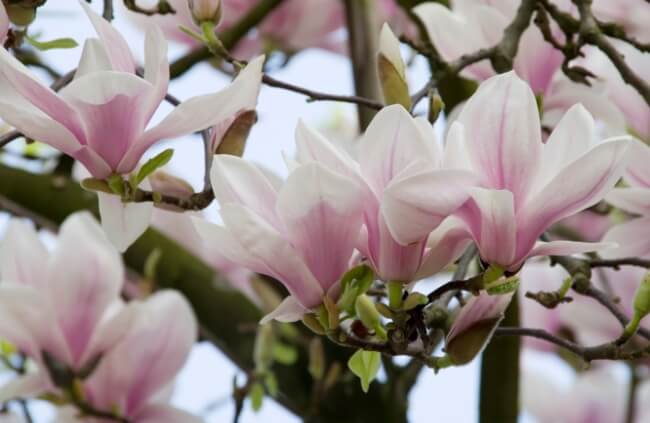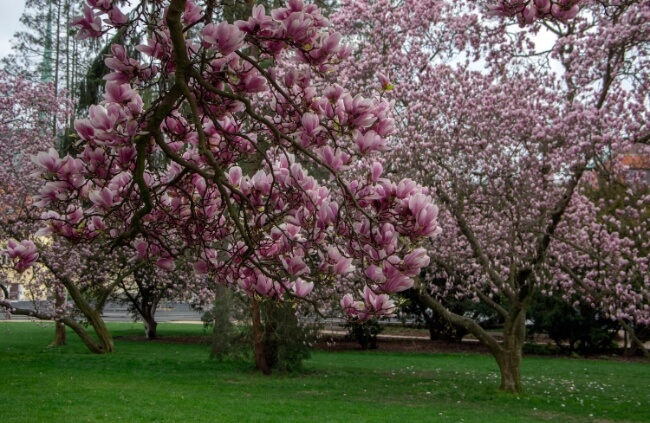Thanks to its reliable late-winter flowering, and spectacular blooms, the saucer magnolia (Magnolia x soulangeana) is one of the most popular magnolias in every corner of the globe. Its gigantic flowers are an impressive indication of spring, and once dropped, the resulting foliage is worth much more credit than it gets.
If you’ve ever wanted to plant a magnolia but didn’t know where to start, we’ve got you covered with this guide. Magnolia x soulangeana is one of the easiest cultivars to grow, thanks to some clever breeding that led to this beautiful magnolia hybrid.
More...

Family: | Magnoliaceae |
|---|---|
Genus: | Magnolia |
Species: | Magnolia x soulangeana |
Origin: | Hybrid of M. denudata x M. liliiflora |
Common Names: | Saucer magnolia, tulip magnolia |
Location: | Outdoor |
Type: | Tree |
Growth: | 8 m tall |
Sun requirements: | Full sun or light shade |
Foliage Colour: | Green |
Flower Colour: | Pale pink |
Flowering: | Late winter |
Edible Parts: | Edible petals |
Maintenance level: | Low |
Poisonous for pets: | Non-toxic to cats and dogs |
What is Magnolia x soulangeana?
The saucer magnolia is a hardy tree in the Magnolia genus. Its large pink flowers are now synonymous with the genus, and more recognisable to most gardeners than any naturally occurring species.
The beautiful pale silver-grey bark holds a powerful architectural form through winter after dropping richly-coloured autumn leaves. Like all magnolias, the flowering window is limited, but any gardener familiar with this genus will know that it’s the impact, not the timeframe that counts.
Saucer Magnolia’s Natural Habitat
Saucer magnolias, despite being one of the most popular cultivars on the planet, aren’t a natural species. They were hybridised in the 1800’s by French botanist Étienne Soulange-Bodin. His successful cross between Magnolia denudata and Magnolia liliiflora shares many of their species traits but with a hardier character.
Magnolia denudata, the lilytree, is native to central China, and is celebrated for its gorgeous autumn colour as well as its crisp white flower. Magnolia liliiflora, best known as the Mulan magnolia, has deep purple, upright flowers and was introduced to Europe from Japan in the 1800’s, despite being native to southwest China.
Today, there are over one hundred cultivars of Magnolia x soulangeana, including the notable Brozzonii and Candolleana varieties. All share the same dramatic flower form but with subtly varying colourings and growth habits.
How to Grow Magnolia x soulangeana
Saucer magnolias are resilient and adaptable plants, which tend to fare well in pretty much any position, but they do need at least some reliable drainage, good light, and enough nutrients to flower effectively.
Regardless of the age of your magnolia tree, don’t be put off if it doesn’t flower for the first couple of years after planting. They nearly always respond badly to being moved and will recover with time.

Growing Magnolia x soulangeana Outdoors
Magnolias can be effectively bonsaied, but in every case, even with bonsais, they should be kept outdoors all year round. Full-sized Magnolia x soulangeana is a medium-sized tree, growing to at least three metres tall, but typically 5-8 m.
They can be grown as multi-stemmed trees and pruned into a shrub form, or as arching standards with a single trunk. Depending on the look you’re after, select your tree carefully, as it’s hard to encourage a multi-stem tree into a standard without it looking at least a little bit wonky, and vice versa.
Preparing the Soil for Saucer Magnolias
pH balance for magnolias: Magnolias work best on lightly acidic soil (pH of 6.0 – 6.5), but won’t be troubled with slightly more acidic, or closer to neutral soils. If your soil pH is above 7 (alkaline) it’s well worth adjusting the pH before planting as it will have an impact on flowering.
Soil type of magnolias: Other than pH, Magnolia x soulangeana requires moist, loamy soil, rich in organic matter but with moderate to good drainage. They do not cope well with soggy roots, but benefit hugely from an annual mulch of compost, leaf mould of rotted manure.
Planting magnolias: Saucer magnolias generally don’t like being moved, so the more you can minimise any change in soil conditions from their existing pot, the better. 99% of magnolias from garden centres will be grown in a loamy, lightly acidic potting mix, and their roots will be slightly pot bound.


Get Your Free Guide:
Master Growing Australian Natives eBook
A Must Have Complete Guide for Every Australian Garden
Get Your Free Guide:
Master Growing Australian Natives eBook
A Must Have Complete Guide for Every Australian Garden
Dig a hole that’s twice the depth and width of the current container, then tease out the roots, and rub some mycorrhizal fungi directly onto the roots to encourage connections with the soil. Water well for the first few weeks to make things easier for your new saucer magnolia.
Light and shade for saucer magnolias
Saucer magnolias grow best in full sun, but will tolerate light shade. If they are grown in the southern shadow of larger trees or houses, they will continue to develop and flower, but tend to be taller, so selecting a good multi-stemmed specimen will help to create a better shaped tree in the long run.
If planted in full sun, any form of Magnolia x soulangeana will thrive.
How to Grow Magnolia x soulangeana in Pots
Despite being really quite large trees in nature, Magnolias do well in containers, and will generally adapt to those conditions, as well as responding to height and width limiting pruning.
We’ve had a saucer magnolia in a large terracotta pot for around five years now. It’s a beautiful multi-stemmed specimen from a local nursery, and despite having reached the limits of the container, it continues to flower vigorously, and holds its foliage late into winter.
To plant your saucer magnolia in a container, just make sure to select something that’s at least 2 ft wide, and 2 ft deep. If you can place the container directly onto bare well-drained soil, even better. If it’s on a patio or hard ground, make sure it has some chocks to allow for drainage.
How to Propagate Saucer Magnolias
Saucer magnolias are so widely cultivated and hybridised for one reason above all else; they’re easy to propagate. While cuttings from magnolias of any type are hit and miss, if you do enough, some will work.
When it comes to planting seeds in Australia, you’ll need a fridge and an air-tight container to get things moving.

Propagating Magnolia x soulangeana from Seeds
Magnolia x soulangeana requires a period of cold to germinate, and a period of dormancy to thrive in their first full year.
You’ll need fresh seeds to start with, so collect your own, or ask a friend if you can collect seeds after flowering has finished and the seeds have ripened in late spring.
You’ll need:
- Fresh saucer magnolia seeds
- An airtight container
- Perlite
- Potting soil
- Several sizes of pots
Method:
- Clean off your magnolia seed, and place it in a container half filled with moist perlite
- Cover the seed with more perlite and mist it.
- Put the lid on the air-tight container and store it at the back of the fridge for up to five months.
- In or around April, plant the seed into a small pot filled with moist seed compost.
- Mist regularly and keep in a bright location through autumn.
- Germination should be apparent by late autumn, but the plant will go dormant for winter.
- In spring, when new growth appears, plant the young magnolia into a slightly larger pot until it’s large enough to treat as a mature plant (about 2 ft tall).
Magnolia x soulangeana Propagation from Cuttings
Magnolia cuttings aren’t exactly reliable, but they are easy to take. So, take more than you need, and be prepared for some disappointment.
- Before you begin, fill a small pot with perlite, and leave it to soak in a tray of water. Make sure the perlite is wet through before using, as this will hold the necessary moisture for the first few weeks.
- Take a 15-20 cm cutting from the top section of a non-flowering young shoot in summer.
- Remove every leaf other than the top pair, and make a neat cut right below the lowest node.
- Cut a slice up the stem, through the lowest node, creating a 5 cm section of split stem.
- Dip the cut section in rooting hormone, and pop it into a pot filled with moistened perlite.
- Cover the pot with a plastic bag, and leave it somewhere warm and bright but out of direct sunlight.
- Mist the cutting twice a week, or when the perlite dries out.
- After four weeks, gently pull the cutting to see if it has rooted.
- Once rooted, plant into a large container filled with a loose, free-draining potting mix.
- Once it’s rooted in that, and new growth is clearly developing it can either be grown in a pot, or planted into the ground.
How to Care for Magnolia x soulangeana
Established Magnolia x soulangeana doesn’t require much care, but they benefit from regular irrigation through Australian summers, and mulching in spring. Supporting young magnolias, or those within the first three years of planting is a little bit different, and much more important when helping them to establish happily in your garden.

Mulching Magnolia x soulangeana
Mulching saucer magnolias should be a pretty routine part of your gardening year. Every year in spring, while they’re flowering, add at least 5 cm of mulch around the base of the tree.
This helps to lock in moisture for summer, and a good organic mulch like homemade compost or leaf mould will support the tree more generally, offering energy for the next flowering season.
Keep a 10 - 15 cm ring around the trunk without any mulch to prevent any sort of contact rot at the base of young trees.
Check out our in-depth guide on the different types of mulch and how to use them.
Fertiliser for Saucer Magnolia
There are some great slow release magnolia fertilisers, which are specially constituted for these beautiful flowering trees, but any acid-loving plant food will work. Camellia food, or fish, blood and bone fertiliser, sprinkled around the tree on moist soils, will help to add nutrients without increasing moisture retention unnecessarily.
Water requirements
For the first year, and second summer after planting, water the tree deeply once a week. In winter, water slightly less frequently but make sure the soil doesn’t dry out completely.
Once established, your saucer magnolia will only need a drink during prolonged droughts.
Pruning Magnolia x soulangeana
Established saucer magnolias don’t need any ongoing pruning unless you are trying to maintain them as a shrub. If you do ever have to cut a branch from your tree, whether it’s for shape, or for disease prevention, cut back to the next junction so you’re not left with an unnatural shape.
If you decide to lift the crown of a saucer magnolia, choose a main stem to treat as the trunk and remove everything else. Decide on an ultimate height and make sure you’re not taking out any branches that will ruin the shape of the canopy.
It’s much better to leave a few extra trunks with a good canopy than a single trunk and a wonky canopy.
Common Saucer Magnolia Pests and Diseases
Thankfully, these stunning trees are rarely affected by pests or diseases, but there are some general growing problems when the two collide, or the conditions are less than ideal. We’ll cover it all below.
Young magnolia trees can attract aphids, scale insects, and caterpillars, but it usually doesn’t affect the tree too badly. Once fully established, magnolias are incredibly resistant to pests.
Any pest infestation on young plants can be treated with organic insecticides, or by manually removing them.
There are four common fungal problems that can affect overwatered, under-watered or over-humidified magnolia trees. Dealing with pests when they occur, and using clean tools for pruning will generally prevent them, but you can also pick up any fallen leaves to stop the cycle of fungal problems at their root.
Leaf spot
Magnolia leaf spot, characterised by brown or black spots across clusters of leaves in summer and autumn is a common problem, but will usually resolve itself the following year.
If leaf spot is affecting the entire tree, it’s likely due to high-than-average humidity in combination with pest damage. If you treat the pests and keep on top of it, it shouldn’t happen again.
Root rot
Evenly yellowing foliage during summer or autumn may be a sign of overwatering, and should be resolved as quickly as possible in case it leads to an established case of Phytophthora root rot, which prevents any nutrient uptake from the roots, and will slowly kill the tree.
Yellow leaves like this are either caused by over-watering or under-watering, so adjust the soil drainage in either direction depending on the symptoms.
Sooty mould
Sooty mould can be mistaken for leaf spot in its early stages, but if you look up close there will be a soft layer of mould over the surface of leaves, rather than discoloured patches.
Treat with neem oil or horticultural oil for an organic treatment in later stages, or simply remove the affected leaves.
Powdery mildew
Powdery mildew affects pretty much every species of plant in the world, but saucer magnolias do seem to be quite susceptible to it when grown in shady conditions. It usually happens in late summer in humid weather patches, and can be treated with a fine spray of neem or horticultural oil.
Magnolia x soulangeana Frequently Asked Questions

Can you keep Magnolia x soulangeana small?
Magnolia x soulangeana can be kept small with regular pruning, even to the point of bonsai. The basic principles of good pruning apply though. Don’t trim it like a hedge. Instead, take care to cut each branch back to the next fork.
Can you plant Magnolia x soulangeana close to a house?
While I wouldn’t advise planting your Magnolia x soulangeana directly next to the house, it can be planted anywhere past 5 m. Their strongest roots will stretch out to match their canopy, so a multi-stemmed specimen will rarely root further than 5 m from the trunk, and those roots won’t be invasive.
How hardy is Magnolia x soulangeana?
Magnolia x soulangeana is an incredibly hardy tree and can cope with drought and frost in equal measure. A freak spring frost could damage this year’s flowers, but the tree will recover into leaf from late spring.
Is Magnolia x soulangeana evergreen?
Magnolia x soulangeana is a deciduous tree, not evergreen. It will reliably lose its leaves each year in winter.
Wrapping Up Our Guide to Growing Magnolia x soulangeana
Magnolia x soulangeana is so widely cultivated that it’s easy to forget its Chinese origins. It’s a gorgeous choice for any oriental garden design, and hardy through all seasons, offering reliable flowers at the end of winter, to mark the start of spring as a result.
And it’s not just a beautiful tree, for any plant nerds out there, the saucer magnolia is one of the most important hybrids in botanical history, and well worth growing for that alone. Plus, it’s easy to grow Magnolia x soulangeana, and the rewards are endless, so there’s no excuse.
Published on August 30, 2023 by Gary Clarke
Last Updated on September 20, 2024




